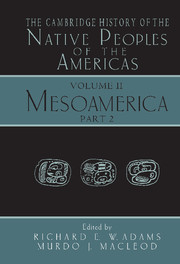Book contents
- Frontmatter
- 12 Mesoamerica Since the Spanish Invasion: an Overview
- 13 Legacies of Resistance, Adaptation, and Tenacity: History of the Native Peoples of Northwest Mexico
- 14 The Native Peoples of Northeastern Mexico
- 15 The Indigenous Peoples of Western Mexico from the Spanish Invasion to the Present
- 16 Native Peoples of Colonial Central Mexico
- 17 Native Peoples of Central Mexico Since Independence
- 18 Native Peoples of the Gulf Coast from the Colonial Period to The Present
- 19 The Indigenous Population of Oaxaca from the Sixteenth Century to the Present
- 20 The Lowland Mayas, from the Conquest to the Present
- 21 The Highland Maya
- Index to Part 2
- Map 12.1: A general map of Mesoamerica, showing major ancient, colonial, and modern population centers"
15 - The Indigenous Peoples of Western Mexico from the Spanish Invasion to the Present
Published online by Cambridge University Press: 28 March 2008
- Frontmatter
- 12 Mesoamerica Since the Spanish Invasion: an Overview
- 13 Legacies of Resistance, Adaptation, and Tenacity: History of the Native Peoples of Northwest Mexico
- 14 The Native Peoples of Northeastern Mexico
- 15 The Indigenous Peoples of Western Mexico from the Spanish Invasion to the Present
- 16 Native Peoples of Colonial Central Mexico
- 17 Native Peoples of Central Mexico Since Independence
- 18 Native Peoples of the Gulf Coast from the Colonial Period to The Present
- 19 The Indigenous Population of Oaxaca from the Sixteenth Century to the Present
- 20 The Lowland Mayas, from the Conquest to the Present
- 21 The Highland Maya
- Index to Part 2
- Map 12.1: A general map of Mesoamerica, showing major ancient, colonial, and modern population centers"
Summary
THE CENTER-WEST AS CULTURAL REGION AND NATURAL ENVIRONMENT
Over the past several millennia the physical asperities of western central Mexico – of alpine ranges, lacustrine basins, arid canyon lands, and humid Pacific fringes – have softened and contracted upon each other under the continuing impact of human habitation, and more recently of modern technologies of transport and communication. Even at the end of the twentieth century, however, they still constitute a difficult geography. Nor have progressive integration into a national state or the homogenizing influence of modernity completely eroded the unique characteristics of the several remnant native regional cultures that cohabit in the Center-West. Nonetheless, as in most of what has been called Indo-America the heritage of indigenous culture remains strongest in areas such as the Michoacan highlands, where native population was densest and state-level polities most developed at the advent of the Europeans, or most isolated from contact with the European colonists and subsequent national society, such as the mountains of Nayarit. Those zones less densely settled at the arrival of the Spanish, less culturally advanced, or more quickly and thoroughly depopulated by disease or emigration – such as the hot plains of the Pacific littoral, or the high, cool, semi-arid steppe country of the Altos of Jalisco – more closely resemble the “neo-Europes” the invaders invented for themselves with their material technologies, their cultigens, and their livestock in far-flung corners of the New World, the South Pacific, and Africa (Map 15.1).
Keywords
- Type
- Chapter
- Information
- The Cambridge History of the Native Peoples of the Americas , pp. 136 - 186Publisher: Cambridge University PressPrint publication year: 2000
- 5
- Cited by

